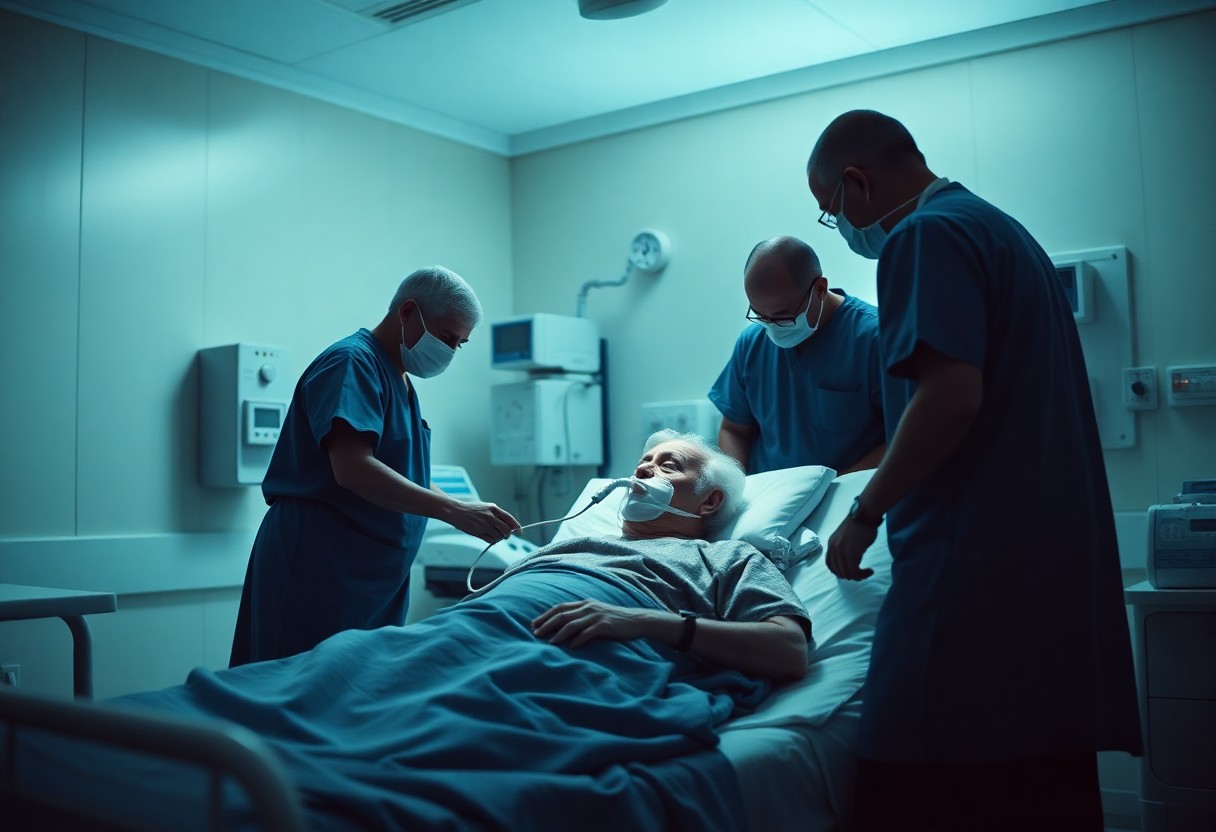It’s important for you to understand what double pneumonia is, especially in light of Pope Francis’s recent hospitalization due to this serious condition. Double pneumonia typically indicates an infection in both lungs, which can arise from various causes, including viruses and bacteria. As you learn about double pneumonia, you’ll discover its symptoms, risks, and the necessary treatment options, empowering you to make informed decisions about respiratory health.
Understanding Double Pneumonia
For elderly individuals like Pope Francis, double pneumonia can pose significant health risks. It occurs when both lungs become infected, leading to symptoms such as difficulty breathing, high fever, and cough with unusual mucus. Timely identification and appropriate care are vital for recovery.
Definition and Symptoms
Understanding double pneumonia involves recognizing that it typically arises from infections such as the seasonal flu or COVID-19, and can manifest through severe respiratory distress. Symptoms to watch for include intense coughing, rapid breathing, and chest pain, emphasizing the need for prompt medical evaluation.
Risk Factors in Elderly Patients
The risk factors for double pneumonia in elderly patients become increasingly pronounced. With aging, your immune system weakens, making it harder to fight off infections. Moreover, age-related chronic conditions can exacerbate the severity of pneumonia, as can lifestyle factors like smoking. Key risk factors include:
- Age over 65
- Pre-existing health conditions (like asthma or COPD)
- Smoking and environmental exposures
Knowing these factors can help you take proactive steps toward maintaining respiratory health.
And while not every elderly individual will develop double pneumonia, understanding the risks can guide your awareness and preventative measures. Enhanced care, vaccination against common illnesses, and routine health check-ups are important strategies. You should consult with healthcare professionals to develop a personalized plan. Important factors include:
- Prompt treatment of respiratory infections
- Strong immunization history
- Healthy lifestyle choices
Knowing these steps can facilitate better outcomes should a respiratory infection arise.
Polymicrobial Respiratory Infections
The presence of a polymicrobial respiratory infection indicates that you may be dealing with multiple pathogens simultaneously, such as various bacteria or a combination of bacteria and viruses in your lungs. This situation can complicate your recovery, making timely and effective treatment necessary for optimal health outcomes.
Multiple Organism Infections
Infections involving multiple organisms can be particularly challenging, as they may require a more tailored approach to your care. It’s important to understand that while having multiple pathogens in your respiratory tract can sound alarming, receiving appropriate antibiotics or antivirals can effectively address each component of the infection.
Common Bacterial Combinations
For many patients, one notorious combination consists of influenza paired with a bacterium such as Streptococcus pneumoniae or Staphylococcus aureus. These common bacterial infections often follow a viral illness, leading to more severe respiratory symptoms that necessitate close monitoring and tailored treatment.
Common bacterial combinations can pose a significant threat, especially in older adults like Pope Francis, who may already be at a higher risk for severe illness. Understanding these combinations not only helps you better grasp your condition but also emphasizes the importance of prompt diagnosis and effective treatment. Timely intervention is key in preventing complications and ensuring a smoother recovery process.
Diagnosis and Detection
There’s a comprehensive process involved in diagnosing double pneumonia, especially in elderly patients like Pope Francis. The combination of clinical assessments and diagnostic tests helps healthcare providers understand the severity and nature of the infection. Early detection is key to initiating effective treatment and improving patient outcomes.
Clinical Assessment
On your visit to a healthcare provider, they will begin with a clinical assessment, which includes a thorough medical history and physical examination. They will listen for abnormal lung sounds and observe for signs such as difficulty breathing, fever, or changes in mental state. This initial evaluation sets the stage for further diagnostic steps.
Diagnostic Tests
Detection of double pneumonia often involves various diagnostic tests. Your healthcare provider may order a chest X-ray to visualize the lungs and identify the presence of fluid or areas of infection. Additionally, blood tests and sputum cultures can help determine the specific organisms responsible for the infection, guiding appropriate treatment.
To ensure effective management of double pneumonia, tests like pulse oximetry may also be performed to measure oxygen levels in your blood. In some cases, a CT scan may be recommended for a more detailed view of lung abnormalities. Timely and accurate testing is necessary, particularly given the increased risk of serious infection in individuals over 80, as seen with Pope Francis’ case.

Treatment Approaches
Once again, managing double pneumonia effectively requires a comprehensive strategy to combat the infection and support recovery. This typically involves a combination of medications and supportive care to address the specific needs of each patient. As you navigate this journey, it’s crucial to work closely with healthcare professionals who can tailor the approach to your situation, considering factors like age and overall health.
Medication Options
On the medication front, antibiotics or antiviral medications are typically the primary tools used against the pathogens causing double pneumonia. Depending on whether the infection is bacterial or viral, your healthcare provider will prescribe the most appropriate medication to combat the illness effectively.
Supportive Care Methods
Methods of supportive care are equally important in ensuring a successful recovery. This can include supplemental oxygen, intravenous fluids, and therapies that help ease breathing difficulties. Personalized attention to your symptoms can enhance overall comfort and promote healing during your hospital stay.
Plus, implementing supportive care approaches may also involve physical therapies that assist with lung function, enabling better oxygenation and fewer complications. With vigilant monitoring, your healthcare team can swiftly adjust these supportive measures according to your needs, ensuring you’re on track for recovery amidst the challenges presented by double pneumonia.
Complications and Risk Management
Your awareness of complications associated with double pneumonia can help you take proactive steps in managing your health. In elderly patients, complications may include respiratory failure, sepsis, or lung abscesses. These issues can escalate quickly, especially in individuals over 80, who face a mortality rate as high as 30 percent when dealing with such infections.
Age-Related Complications
Among older adults, the risk of complications from double pneumonia increases significantly. With each passing year, your risk for severe infections rises, emphasizing the importance of closely monitoring any respiratory symptoms and seeking prompt medical care when necessary.
Prevention Strategies
Between vaccinations and good hygiene practices, you can implement effective prevention strategies to reduce your risk of pneumonia. Ensuring you’re up-to-date with vaccinations for flu and pneumococcal disease is key, especially if you’re over 65. Additionally, practicing good hand hygiene and avoiding close contact with sick individuals can further lower your risk.
Complications from double pneumonia could be life-threatening, particularly in elderly patients. Staying vigilant about your health, especially during flu season, can minimize your risk of developing pneumonia. Regular check-ups, a healthy diet, and avoiding smoking can also bolster your immune system, making you less susceptible to respiratory infections. Always consult your healthcare provider for personalized advice and when considering treatment options.

Hospital Care Protocol
Not only is timely diagnosis necessary, but the hospital care protocol for double pneumonia typically includes a combination of antibiotics or antiviral medications, along with supportive therapies to manage symptoms effectively. You can expect a thorough assessment of your respiratory function and other vital signs to determine the appropriate course of action as your healthcare team closely monitors your condition.
Inpatient Treatment
Against the backdrop of a serious infection, inpatient treatment might involve intravenous fluids, oxygen therapy, and targeted medications to combat infections. Your healthcare team will tailor the treatment based on your specific needs, ensuring that you receive the right care for your recovery.
Monitoring Requirements
Requirements for monitoring during hospitalization are stringent, as healthcare providers will frequently check your vital signs, including heart rate and oxygen levels, to assess your response to therapy. This continuous observation helps in promptly identifying any complications that may arise due to the infection.
Consequently, consistent monitoring is necessary in managing double pneumonia effectively. Your healthcare team will regularly perform chest X-rays to evaluate lung inflammation and conduct blood tests to track infection levels. This proactive approach aids in adjusting your [treatment](https://bit.ly/PerKETODiel) plan as needed, ensuring you receive the safest and most effective care throughout your hospital stay.
Conclusion
Following this, understanding double pneumonia’s complexities can help you recognize its severity, particularly in elderly patients like Pope Francis. This respiratory infection, while treatable, poses significant risks, and being informed about symptoms and potential treatment options is crucial. If you or a loved one experience symptoms such as difficulty breathing or a severe cough, seeking immediate medical attention can be critical, as timely diagnosis and appropriate treatment significantly improve outcomes.


